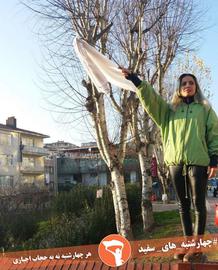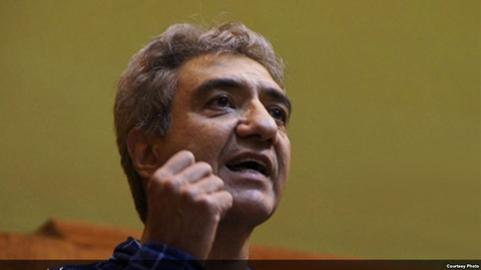This is the third article in IranWire’s series Decoding Iranian Politics. The series examines the building rift between Iran’s various political factions, goes behind the scenes of the country’s fiercest political scandals, and looks at how citizens are responding to the country's political climate, as well as taking stock of some of the most defining moments in recent history.
What do Recent Protests Mean for the Mandatory Islamic Headscarf?
Since the establishment of the Islamic Republic, Iran’s leaders have portrayed women’s mandatory veiling code as an essential indicator that Islamic rule has been a success in the country. However, in reality, the compulsory hijab has always faced challenges from large numbers of Iranian women.
For decades, this challenge has mostly been in the form of women wearing their hijabs loosely when out on the streets or, in recent years, removing their headscarves while in their cars. This challenge, however, entered a new phase in late December 2017, when an Iranian woman named Vida Movahhed removed her headscarf and waved it on a stick in front of her in one of the most populated streets of Tehran. She staged her protest just days before the beginning of the late December-early January street protests, though it had no connection to those protests.
While protests about a number of issues — from corruption and the economy to workers’ rights — spread across Iran in early January, individual women were inspired by Vida Movahhed’s public action and followed her example by removing their headscarves in public. Iranian police officially confirmed that by the beginning of February, 29 people had been arrested for unveiling in public places.
The majority of these acts were performed in Tehran, but women staged similar protests in other cities too. In one display in Mashhad, a woman in black chador, a full-body-length hijab, tied a headscarf to a stick and waved it in front of her. Although she had clearly chosen to wear hijab, she protested against the compulsory imposition of hijab on those women who do not believe in wearing it.
Many Iranians have supported these public challenges to the compulsory hijab on social media, as have dozens of Iranian public figures – including veiled women. At the same time, many Iranian personalities have not given support for these acts of defiance, but have criticized the state’s policy on imposing hijab by force.
With respect to the recent challenges to the compulsory veil, the role of an Iranian feminist activist Masih Alinejad cannot be ignored. Alinejad, who is currently based in the United States, launched an online campaign named My Stealthy Freedoms in May 2014, encouraging Iran-based women to challenge the law on forced hijab by posting photographs of themselves not wearing scarves. In May 2017, she launched the White Wednesdays campaign, encouraging women to publicly remove their headscarves on Wednesdays or wear white scarves as a symbol of protest.
According to Vida Movahhed, her public protest was an act of solidarity with the White Wednesdays campaign.
How Did the Islamic Republic Make Hijab Compulsory?
Hijab was made mandatory in Iran in several stages. Just a few weeks after the victory of the Islamic revolution in 1979, Ayatollah Khomeini stressed that women should wear the veil. Nevertheless, his remarks did not lead to specific government actions until July 1980, when Khomeini stressed that the Islamic dress code should be observed in government offices. The government then made it obligatory for women working in public offices to follow this code.
Finally, in August 1983, the Iranian parliament made hijab mandatory for all women. According to the new law, women who appeared in public places without wearing an Islamic hijab could be fined, imprisoned or even sentenced to up to 74 lashes.
It should be borne in mind that there are different levels of punishment for not wearing hijab and removing it in public as a sign of opposition, as has happened since late December 2017. Two months after the beginning of the recent acts of defiance, Iran’s police announced that women who unveiled to protest against the compulsory hijab would be charged with “inciting corruption and prostitution,” which can carry a maximum sentence of 10 years in prison.
In late February 2018, Iran’s judiciary started conducting trials for women who had defied compulsory hijab in public. So far, a few women have received jail sentences for up to two years. The other arrested women, most of whom were released after settling heavy bail amounts, still await their trials.
So why is Iranian Regime so Over-Sensitive About Hijab?
Under the rule of the Muslim prophet Muhammad, hijab was not obligatory and unveiled women were not subject to punishment. In the Koran, Muslim women are advised to wear hijab, but it does not mention punishment for women who are unveiled. By contrast, there are many specific acts that are highlighted in the Koran as being unforgivable sins and these were forbidden in Muhammad’s era too. And yet, they are widely tolerated in the Islamic Republic of Iran. One well-known example is the fixed interest rate, known as riba — usury — in Islam. Not only is it not banned in Iran, it is the basis of Iran’s banking system. In fact, despite many Iranian Grand Ayatollahs’ permanent opposition, the Islamic Republic has never, and possibly will never, ban fixed interest rates in the country’s banking system.
In order to justify the compulsory hijab in Iran, the defenders of this obligation say that an Islamic state has the authority to impose specific rules on the basis of expediency or the requirements of the time. They also maintain that the compulsory veil is a law in Iran, therefore, must be imposed by law enforcement forces.
Nevertheless, restoring the compulsory hijab has been one of Iran’s law enforcement agencies’ most costliest missions over the last four decades. During this period, a considerable proportion of the police capacity has been patrolling the streets looking for those women (and men) who do not abide by the country’s dress code. As a result, thousands of law enforcement staff have permanently been involved in these endless patrols, preventing the state agencies from using these officers to combat what might be described as “real” crimes or infractions.
It seems that this costly approach is, first and foremost, the result of the iconic role the Islamic hijab holds in Iran. It is true that many religious rules, such as the prohibition of riba or fixed interest rates, are not observed in Iran. But restoration of hijab in public places, even a minimal type of it, is viewed as being inseparable from the concept and values of the Islamic Republic of Iran and proof that the country is ruled by Islamic law. Thus, in the eyes of the ruling conservatives, this very visible, obvious specification seems much more essential than the observation of sharia law in less visible areas of people’s social or economic lives.
Besides, after decades of tough confrontation between the Islamic regime and women over the compulsory veil, any sign of Iranian rulers retreating from the enforcement of hijab will be interpreted as a historic defeat for the regime and evidence that it is going back on its principles.
The loose headscarves worn by a great proportion of Iranian women have nothing to do with the Iranian regime’s definition of the Islamic hijab. But many Iranian authorities believe if the regime is seen not to be reacting to unveiled women, millions of women will be encouraged to remove their headscarves.
This, in their opinion, would lead to the total destruction of the Islamic Republic’s authority in the country’s public sphere..
visit the accountability section
In this section of Iran Wire, you can contact the officials and launch your campaign for various problems

























comments